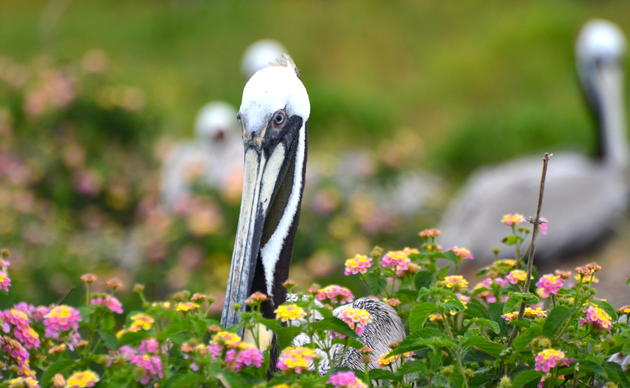Brown Pelican
As recently as the early 1970s, Brown Pelicans were in jeopardy due to organochlorine pesticides. By 1970 all North American populations (with the exception of some in Florida) were gone; the species was placed on the Federal Endangered Species List throughout its range. Their growing abundance in the U.S. since the banning of DDT represents a conservation success story. The total U.S. population size now exceeds historical levels, the number of breeding pairs in most states is stable or increasing, and Christmas Bird Counts and Breeding Bird Survey data both show increases. The birds were removed from the Endangered Species List in the southeastern United States in 1985; however, endangered status has been retained throughout the remainder of its range.
Conservation Issues
Through the early 1900s, shooting for the millinery trade and to "protect" fishing caused major Brown Pelican declines. Legal protection began in 1903 when Pelican Island, Florida was set aside as a federal preserve. Despite the birds' longevity and popularity, Brown Pelicans nearly disappeared from North America between the 1950s and 1970s. The pesticide endrin killed pelicans outright, and DDT caused thin-shelled eggs that broke under the weight of incubating parents. DDT use was banned in the United States in 1972.
Despite their subsequent strong recovery, Brown Pelicans remain highly susceptible to oil spills. Breeding, roosting, and foraging sites are often near heavily trafficked shipping channels. Entanglement in fishing gear causes the deaths of 700 birds each year in Florida alone, where 80% of live birds examined show injuries from fishing gear. Pacific and Peruvian populations experience low productivity during periodic El Nino events, when warm surface water reduces prey availability.
Pelicans disturbed by gunshots from hunters, boat traffic, and visiting humans, including researchers, show greatly reduced reproductive success. Nestlings are crushed when parents flush in panic, and unattended eggs and nestlings succumb to predators and hyperthermia.
In the Carolinas, reduced nest numbers have resulted from the erosion of key nesting islands. Dredge spoil has been successfully used to rebuild some of these islands. Breeding populations were successfully re-established in Louisiana by transplanting nestlings from Florida. Other recovery plan recommendations include habitat protection, reduced disturbance, monitoring of contaminants and populations, and public education. Most U.S breeding sites are now protected by federal or state agencies or conservation groups, such as the National Audubon Society.
How you can help, right now
Join Audubon Texas Today
Becoming a member supports our local work protecting birds and the places they need.
Consider a Legacy Gift for Texas
Planned gifts and bequests allow you to provide a lasting form of support to Audubon Texas.
Subscribe to Our Newsletter
Subscribe to our newsletter for updates about Audubon Texas's conservation work, and news about our activities and local events.




